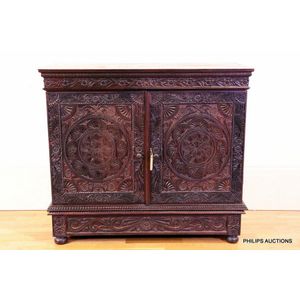Rosewood Cutlery Sideboard with Intricate Carvings
You must be a subscriber, and be logged in to view price and dealer details.
Subscribe Now to view actual auction price for this item
When you subscribe, you have the option of setting the currency in which to display prices to $Au, $US, $NZ or Stg.
- Bun Feet - Similar to ball feet, though somewhat compressed or flattened in appearance. Introduced during the late 17th century, but they have been used on furniture up to the present day.
- Plinth - The square or rectangular base of a piece of cabinet furniture, often ornamented with moulding. The plinth may be separate, as in some wardrobes or presses, and act as the support for the carcase. In a false plinth, the moulded boards may be attached directly to the piece. Furniture with a plinth base usually does not have separate feet. The term derives from architecture where it denotes the base of a column or statue.
- Frieze - An architectural term denoting the flat, shaped or convex horizontal surface of furniture, between the architrave and the cornice, usually found on a cabinet or bookcase, or on desks and tables where it may include drawers, the area between the top and the legs. In ceramics, the term refers to the banding, of usually a repeating pattern, on the rims of plates and vases.
- Circa - A Latin term meaning 'about', often used in the antique trade to give an approximate date for the piece, usually considered to be five years on either side of the circa year. Thus, circa 1900 means the piece was made about 1900, probably between 1895 and 1905. The expression is sometimes abbreviated to c.1900.
- Rosewood - A dense timber that varies in shade to very light brown to almost black. When rosewood is cut and sanded the colour of the timber will turn black, and after polishing and exposure to daylight, the surface will gradually lighten over time to light brown with black streaks.
The name comes from the odour emanating from the timber when it is planed, sanded or cut.
Rosewood was very popular for use in Victorian furniture in the second half of the 19th century, and at that time most of the rosewood was imported from Brazil. However it also grows in India and Indonesia.
It is used in the sold for chairs and table legs, but for carcase furniture such as side cabinets and bookcases, and for table tops it is always used as a veneer.
This item has been included into following indexes:
Visually similar items

An antique French heavily carved walnut coffer. Depicting unusual mythological scenes. Bearing a heraldic shield to lid, 65.5 cm high, 105 cm wide, 58 cm deep

Antique carved oak Renaissance style sideboard, fitted with doors carved in high relief, approx 96 cm high, 115 cm wide, 50 cm deep

18th century oak settle with hinged seat compartment, carved with lion mask arms and floral motifs. Width 12 cm. Provenance: Gerhard Friese Estate

A French Gothic style oak cabinet, circa 1880, of trapezoid shape, the two panelled doors and sides decorated in the Gothic revival manner with scrolls, vegetal motifs, and the fleur-de-lys, medieval style metal handles and embellishments, upon bracket fee
